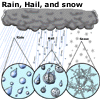 Precipitation
comes in three forms; rain, hail and snow. Each occurs under its own unique
circumstances, but are all formed from the same basic weather mechanisms.
Precipitation
comes in three forms; rain, hail and snow. Each occurs under its own unique
circumstances, but are all formed from the same basic weather mechanisms.
Rain
Raindrops are formed from water condensing out of moist air that cools.
This can occur in three main ways:
- over mountain ranges as moist air is forced to rise into cooler altitudes,
- as warm moist air meets colder air at a "cold front" or
- in storm clouds when hot moist air rises into cooler altitudes as the ground is heated during summer days.
 For
rain to form, small dust particles or ice particles must be present in
the air. Such particles attract the water as it condenses from the cooling
air forming larger and larger raindrops. When the raindrops become too
large to be supported by the upward wind within the cloud, they begin
to fall. Large drops are formed when strong updraughts hold the drops
in the clouds allowing more water to accumulate in each drop.
For
rain to form, small dust particles or ice particles must be present in
the air. Such particles attract the water as it condenses from the cooling
air forming larger and larger raindrops. When the raindrops become too
large to be supported by the upward wind within the cloud, they begin
to fall. Large drops are formed when strong updraughts hold the drops
in the clouds allowing more water to accumulate in each drop.
Cloud seeding
Cloud seeding involves spreading tiny crystals of dry ice (carbon dioxide)
or silver iodide in clouds to create rain. When spread into a potential
rain cloud, the crystals form raindrops large enough to fall, where small
droplets may have remained suspended in the cloud and not fallen as rain.
Each method has its appropriate use. In mainland Australia, dry ice has
been used the most successfully. In Tasmania, silver iodide is used.
The use of cloud seeding in Australia is rare and only the right clouds can be seeded. For a cloud to be successfully seeded it must be supersaturated with water, that is, it is cold enough to rain, but the droplets have not formed. This can happen if the air is very clean and lacks the dust required to form the initial droplets.
Hail
 Intense
updraughts created in a severe storm can suspend very large drops of water
and even blow drops back up high into the tops of the storm clouds. If
the rising droplets reach a high enough altitude the water freezes, forming
hail. If the process of falling and being blown back high into the storm
cloud continues, larger and larger hailstones are formed. Ultimately the
hailstones gain enough mass to fall to Earth.
Intense
updraughts created in a severe storm can suspend very large drops of water
and even blow drops back up high into the tops of the storm clouds. If
the rising droplets reach a high enough altitude the water freezes, forming
hail. If the process of falling and being blown back high into the storm
cloud continues, larger and larger hailstones are formed. Ultimately the
hailstones gain enough mass to fall to Earth.
Hail is usually associated with tropical or summer thunderstorms. Stones as large as cricket balls are not uncommon in Australian storms.
 Snow
Snow
Snow is created when very cold conditions freeze the water as it condenses
in the clouds. The crystals of snow form like rain around dust, but form
light transparent ice crystals we know as snow, instead of raindrops.
For snow to land, the temperature must be below 0°C, the freezing
point of water.
Sleet is snow that has semi-melted while falling, having none of the beauty of snow, lacking the intricate hexagonal symatry of snow flakes and all the charisma of very cold rain!
| Copyright owned by the State of Victoria (Department of Education and Early Childhood Development). Used with Permission. |
|
|||||||||||||||||||||||